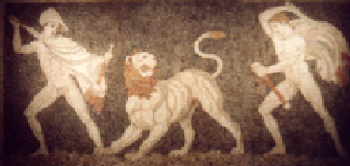Birthplace of Philip and Alexander

|
Pella Birthplace of Philip and Alexander |
 |
History
The ruins of the city were found by chance in 1957 and are still in the process of excavation. We can see the remains of two houses, some mosaics in situ and more mosaics and other finds in the museum. The agora and palace are not open to visitors. Philip II of Macedon (382-336 BC) and his son Alexander were both born and lived here.
Pella became the capital of the region known as Macedonia when King Archelaos I (413 - 399 BC) moved his court there from Aigai (now known as Veryina) , as part of his efforts to transform Macedonia from a region despised by the city states of southern Greece, who considered the inhabitants to be uncouth, with a reputation for drunkenness. (They called them 'barbarians', a word now synonymous with rough behaviour but originally thought to refer to the language which sounded like 'bar bar'). The reputation for heavy drinking may be deserved but the beauty of the mosaics at Pella, the fine paintings in the tombs and the gold found at Veryina would suggest they also had a taste for the finer things of life. Archelaos encouraged people of culture to his new court, including Euripides, whose play The Bacchae was first performed in the theatre here and who died here in 406 BC. (Socrates was also invited but declined.)
The assassination of Arkelaos in 399 brought an end to the development of Pella, and over the next forty years or so there were seven or eight kings. In 359 Philip II, son of Amyntas II, became king on the death, in battle against the Illyrians, of his brother Perdikas. During his reign and that of his son Alexander the city became prosperous and powerful, and capital of Philip's 'unified' Greece.
During this time it was linked to the sea by a canal. The city was sacked by the Romans in 146 BC, and destroyed by earthquake at the end of the first decade of 1st century BC c95-90
The Museum:
The new museum is fabulous and full of wonderful things, many of which come from houses on the site and so enable us to imagine life in 4th century Pella.
The stunning mosaics which were displayed on the wall in the old museum are now on the floor ( as they would have been originally); we go up a continuous ramp to a gallery from where we can look down on the mosaics.
They come from two of the houses on the site (late 3rd - early 2nd century BC). There were two distinct types of houses in Pella; the House of Dionysos, (named after the mosaic found there) is an example of the type with an interior porch (peristyle), and the second, the house of the Abduction of Helen, has a courtyard, the focus of family life. The rooms in daily use and those used for receiving guests were on the northern side, which usually had an upper floor.
The walls were built of stone up to a height of about 1 metre and then of brick. The inside was always plastered in the First Pompeian style.
The floors were decorated with mosaics made of tiny uncut natural sea pebbles, outlined with lead or clay, with semi precious stones, now missing, for the eyes. The mosaics on display here are floors from the houses over the road, dating 325-300 BC, most of them in excellent condition. The magnificent lion hunt is from the central part of the andron (banqueting room) in the House of Dionysos, and is thought to represent the scene when Alexander was rescued from a lion during a hunt at Granikos. The two young hunters, naked apart from flowing capes, stand either side of the lion with their weapons raised poised to stab the lion; one has taken his sword from its scabbard, the other, who wears a petasos (a Macedonian style hat), has a spear in one hand, his sword, still in its scabbard, in the other. (The wonderful lion looks somewhat bemused, poor thing!). The outlines of the figures are shown in fired clay.
The rather damaged mosaic of a griffin devouring a deer is also from the entrance to an andron of Dionysos' house. The griffin with huge wings and long curling tail has grasped the stag with its claws and is digging its teeth into his back - drops of blood fall from the wound.
Another superb mosaic shows Dionysos, holding a thyrsos with a swirling red and white ribbon and sitting naked on a beautiful prancing panther, (a bit of a poseur?). Strips of clay are used for Dionysos' curly hair and green and red tesserae for his wreath and the ribbon.
The late Hellenistic period marble head of Alexander has the characteristic upwards tilt, said to be caused by 'ocular torticollis'.
I like the black and white slate circular table top, beautifully inlaid with flowers, and meander pattern. I've never seen anything like it, it was found in the house next to the House of Helen.
There are some beautiful bronze bed posts (fulcra) with horses heads.
There are also many objects found in the agora. In particular lots of rather nice, 2nd century, terracotta female figures/statuettes, some moulds from the workshops, and vases. Look out also for the lovely stele with a farewell scene of a mother and baby, a beautiful bronze arm of a statue, some fine gold wreaths and jewellery found in the cemetery,